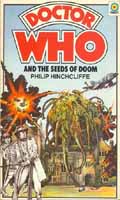The Seeds of Doom
Doctor Who and the Seeds of Doom

|
The Seeds of Doom |
Target novelisation Doctor Who and the Seeds of Doom |

|
| Author | Philip Hinchcliffe |  |
| Published | 1977 | |
| ISBN | 0 426 11658 5 | |
| First Edition Cover | Chris Achilleos |
| Back cover blurb: In the snowy wastes of blizzard-swept Antarctica, a strange pod-like object is unearthed, buried deep in the ice. Curiosity turns to alarm as the pod begisn to grow - then horror when suddenly it cracks open and a snaking green tendril shoots out, mercilessly seeking the nearest live victim... In London, the botanical experts are bewildered. DOCTOR WHO is called in to fight this unknown horror. But will he be in time to save Earth from the rapidly spreading tentacles of the KRYNOID, giant man-eating monster from an alien world? |
A strange first adaptation by Tim Roll-Pickering 6/2/04
New adaptors are always welcome to the Target range and the arrival of Philip Hinchcliffe, just at the point when he finished producing the television series, bodes well for diversity. Hinchcliffe's first novelisation is based on one of the stories he produced on television, yet it is one of the stories most at odds with his vision of the series. In most of the stories in Seasons 12 through 14 the Doctor is a wanderer at heart, breaking free of the trappings of Earth and only reluctantly returning when he receives a distress call, expressing his clear dislike at this both during and after the event (witness both Terror of the Zygons and Pyramids of Mars). Equally he despises being used by the Time Lords to carry out their dirty work, as shown in both Genesis of the Daleks and The Brain of Morbius. This Doctor is very much his own person, going where he likes and not operating out of a fixed location, subservient to anyone. UNIT is present in a few stories but gradually sidelined. There is only one story which really goes against these trends to any significant extent and that story is The Seeds of Doom. So for this story to be the first to be novelised by Hinchcliffe is a real surprise, especially given that many others had at this point yet to be adapted (especially The Ark in Space and all of Season 14).
But what of the book itself? Like Terrance Dicks, Hinchcliffe for the most part follows the course of events in the television stories but chooses to make some ommisions, presumably for brevity. Gone is the silly closing sequence where the TARDIS materialises at the South Pole by accident, despite not having been used earlier in the story. Gone also are the scenes where Amelia Ducat visits Harrison Chase in an attempt to find out what has happened to the Doctor. Instead we just have Sir Colin Thackery and Dunbar in a car outside the estate discussing what is going on before Dunbar enters in an attempt to make up for his treachery, but he quickly comes to grief. Unfortunately this retention comes across as highly redundant to the plot and could have been easily scrapped in favour of a greater explanations as to why the Krynoid lets Chase go free or just what the Doctor means about him no longer being human.
The television story was notable at the time for the Doctor's willingness to use violence to resolve matters, especially in dealing with Chase's thugs and being prepared to threaten with a gun. The violence is present throughout the book and, if anything, comes accross as even harsher here as Hinchcliffe spares nothing in his descriptions. The pace of the book is fast and furious but it fails to resolve some of the problems inherent in the story. Chief among them is the way that the Krynoids are disposed of. The first is blown up by a bomb attached to a generator and the second in an air strike, each suggesting that the matter could have been easily dealt with by the military and that the Doctor's presence in the story was largely superficial if not counter-productive as he was the one who knew to look for the second Krynoid pod. Equally the Doctor now appears to arrive in a situation with a clear encyclopedic knowledge about the new menace, rather than the more traditional route of discovering what the situation and characters are through the development of the plot. The chance to correct this for the book, as well as bringing the story closer to the producer's vision for the series, is clearly there but instead Hinchcliffe chooses to retell the televised story. However his descriptions and characterisation is good, making each significant character seem real through the descriptions, with the result that the novel is a good read. But the niggling thought remains that it could have been better. 6/10